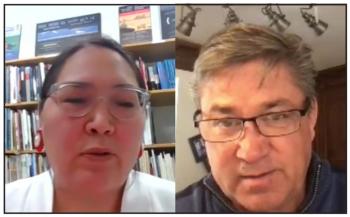Image Caption
Summary
Local Journalism Initiative Reporter
Windspeaker.com
In an emotional presentation on a funding model for Indigenous languages, Nunavut Tunngavik Incorporated President Aluki Kotierk said that when the federal government drafted the Indigenous Languages Act she had failed to make them understand that Inuktut should get the same official language consideration and status in her homeland as English and French.
“Funding models are tools. They are a means to an end. How are we going to achieve our goal?” said Kotierk, speaking as part of a panel on the third day of a five-day virtual symposium on Indigenous languages hosted by Canadian Heritage.
That goal, she said, was for Inuit to be “able to freely and with dignity use Inuktut in all aspects of our life with the expectation of receiving public essential services in Inuktut.”
She said her body “was seizing” when then-Canadian Heritage Minister Pablo Rodriguez introduced the Indigenous Languages Act in February 2019.
“My body was seizing because it felt like a very personal failure on my part that I had not been able to articulate effectively, not only the aspiration that we had as Inuit, but the necessity,” said Kotierk.
“We, as the Métis Nation, support the Inuit’s desire to have public service in the Inuktut language and I don’t think that fight is over,” said Marc LeClair, senior advisor and negotiator for the Métis National Council.
LeClair pointed out that the government was also failing the Métis. He said funding for Métis Nation languages accounted for only 2.25 per cent of the federal Indigenous languages budget.
The Métis Nation is proposing a 10-year accord on languages, he said, similar to the sub-accords the Métis now have with Canada in the areas of housing, early learning and childcare, homelessness, post-secondary education assistance, and the recommitment to employment and training. Those sub-accords have a $2 billion commitment over 10 years that were achieved through the Canada-Métis Accord signed in 2017.
There was not a lot of variance in what was presented by the day’s First Nations, Inuit and Métis-specific break-out groups on funding models compared to what Paul Pelletier, director general, Indigenous Languages, Canadian Heritage, presented earlier in the day.
Pelletier’s slide presentation was a summary of what had been heard during 26 virtual consultations, which began after the Indigenous Languages Act was adopted in June 2019. The department’s objective is to determine how to provide “adequate, sustainable and long-term funding for the reclamation, revitalization, maintenance and strengthening of Indigenous languages.”
During those virtual consultations, the government heard that funding must be distinctions-based. They were also told that the process and funding decisions should be Indigenous-led and community-driven. While the funding is to be flexible it has to be used for Indigenous languages only. Programs that have demonstrated success should be prioritized. The funding model should reflect a whole-of-government approach, which includes education, justice and health. Success needed to be defined and measured.
While virtual consultation said the priority should be given to critically endangered Indigenous languages, one First Nations break-out group on Jan. 27 did not agree.
“Move away from the criteria of endangered languages because the criteria discriminates against languages that are flourishing and if you only focus on endangered languages—your present criteria—there is the risk that those flourishing languages then will become endangered,” said spokesperson Claudette Commanda.
Another difference was noted by Cynthia Jensen Fisk, board chair for the First Peoples Cultural Council (FPCC), who was spokesperson for another First Nations break-out group.
“Funding (would have) to be different than funding for French language speakers at this point because we have been oppressed as language groups for a very long time and (Indigenous languages) will probably need to be more helped in this first little while,” said Jensen Fisk.
Pelletier’s summary said that funding for Indigenous languages needed to “achieve parity” with French and English.
Another point made by Jensen Fisk’s group, was that funding would also be required for infrastructure as many communities don’t have space to house programs or learners.
Aliana Parker, language revitalization program specialist at FPCC and spokesperson for another First Nations break-out group, said it was important that funding be sufficient so communities weren’t competing for limited dollars.
“This continues to be a problem when we’re asking questions about how to allocate funding and whether we should be considering the level of endangerment or regional models, things like that. All of those questions are based on the assumption that the funding is not sufficient and there must be competition and that’s inherently problematic,” she said.
“There is not a formulaic answer to how funding should be delivered, because each community’s situation is very unique,” Parker added.
Commanda’s group was also adamant that dollars provided through the Indigenous Languages Act needed to focus on Indigenous peoples. If non-Indigenous people wanted to learn Indigenous languages that funding needed to come from a different budget.
“The criteria is multi-faceted and I think ultimately the goal is what needs to be focused on and it shouldn’t be a matter of ticking off boxes and seeing if it met a criteria. The outcome is what needs to be the focus,” said Kotierk.
Local Journalism Initiative Reporters are supported by a financial contribution made by the Government of Canada.

